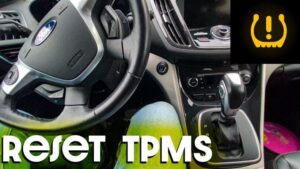Okay, so I’ll admit it—my car’s dashboard lights give me trust issues. One minute I’m cruising with the windows down and a coffee in hand, and the next? BAM. That little orange horseshoe with an exclamation point (aka the TPMS warning light) pops up like it owns the place. Naturally, I did what any millennial with a YouTube addiction would do: Googled my way into a panic spiral. Until I found the magic words tpms reset button and everything changed.
Yes, that mysterious little button exists, and yes, you can reset your tire pressure monitoring system yourself without begging your mechanic for mercy (or dropping $100 for “diagnostic labor”). If you’ve ever had that annoying light haunt you after a tire rotation or seasonal pressure shift, keep reading because I’ve got the tea, the sass, and the step-by-step guide.
What Even Is a TPMS Reset Button and Why Should You Care?
You know that annoying orange light that looks like a flat tire with a tiny exclamation point? That’s your car’s way of telling you the tire pressure isn’t where it should be. Enter: the tpms reset button—a small, often-hidden hero that tells your car to chill and re-check the tire pressures after you’ve fixed them.
So why does it matter? Because even after you pump your tires to the perfect PSI, that light won’t always turn off by itself. Your TPMS system needs a little nudge a digital high-five, if you will to recognize everything’s okay. That’s where this reset button comes in. It clears the system’s memory and starts fresh.
The best part? Once you know where to find it (and how to use it), you’re basically a tire pressure wizard. Cue the smug look when you tell your dad you handled it all by yourself.
Where the Heck Is the TPMS Reset Button in My Car?

Image source: Reddit
The tpms reset button is usually located beneath the steering wheel, either on the lower dash or near the fuse box. Sometimes, it’s hiding under a panel or next to the OBD port like it’s in witness protection. If your car is extra boujee, the reset option might live inside your infotainment system’s settings (looking at you, newer Toyota models).
If you’re totally lost, don’t stress—your owner’s manual is your BFF here. Or Google your car’s make and model followed by “TPMS reset button location.” It’s oddly satisfying when you finally find it, like you’ve cracked a secret code.
Why Won’t My TPMS Light Go Off Even After Adding Air?
Been there. Pumped the tires, double-checked the PSI, and that dang light still shines like it’s auditioning for Broadway.
Here’s the scoop: your TPMS isn’t always smart enough to know you’ve fixed the pressure. It holds onto the old data until you hit that reset. If you don’t use the tpms reset button, the light might linger for days or until you lose your cool and Google it at a gas station (guilty).
Also, make sure your spare tire isn’t flat. Yep, some vehicles monitor that one too. And don’t forget to check all four tires with a reliable tire pressure gauge; those gas station ones can be wildly off.
How Do I Actually Use the TPMS Reset Button?

Okay, so you found it. Now what? Here’s how to make the most of your tpms reset button without screaming into the steering wheel:
First, make sure your tires are inflated to the recommended PSI. (It’s usually listed on the sticker inside the driver’s side door, not the tire sidewall.)
Then, turn your ignition to the “on” position but don’t start the engine. Now, hold down the tpms reset button until the TPMS light blinks three times. This may take around 3–5 seconds depending on your car model.
Let go of the button and start your car. Drive for about 10 to 30 minutes at 30+ mph. This gives the system time to recalibrate and recognize the new pressures.
Still on? Try it again. Some cars are divas and need a second reset. If that fails, it might be time to check the sensors—or, fine, call in a pro.
Can I Reset TPMS Without the Button?
Yes… but it depends on your car. Some vehicles let you reset TPMS through the touchscreen display (luxury, right?). Others do it automatically after a short drive. And then there are the old-school rides that make you perform a tire pressure dance involving ignition cycles and pedal stomping. Not joking.
If your car doesn’t have a visible tpms reset button, check your manual. You might need to access it via your vehicle’s computer system or reset the sensors using a TPMS scan tool (which you can buy or borrow at an auto parts store).
What Cars Usually Have a TPMS Reset Button?
Not all heroes wear capes, some are just Honda Civics. Here’s a quick look at popular brands and whether they generally include the reset button:
| Brand | Typically Has TPMS Reset Button? |
| Toyota | Yes (often near steering) |
| Honda | Yes |
| Chevrolet | Yes (some models) |
| Ford | Rare—often menu-based |
| Subaru | Sometimes—check manual |
| BMW/Mercedes | No—usually touchscreen |
It’s never universal, so when in doubt, pop open that manual or look up your make and model online.
How to Make the Most of TPMS Reset Button

The tpms reset button isn’t just a one-and-done thing—it’s your long-term ally. Make a habit of using it:
- After rotating your tires
- After swapping out winter/summer tires
- When your TPMS light won’t go off after refilling
- If you replace a faulty tire sensor
By resetting your TPMS regularly when it needs it, you’ll avoid the dashboard anxiety, save on mechanic bills, and actually trust that when the warning light comes on, something really is wrong.
Think of it as a soft reset for your car’s memory—it forgets the old drama and focuses on what’s real now. Kind of like you after blocking your ex.
FAQs: Because We Know You’re Still Curious
Can I reset my TPMS with a paperclip or something?
Unless you’re MacGyver, I wouldn’t recommend it. Some older models had you bridge terminals in the OBD port to reset TPMS, but that’s risky if you’re not a tech. Stick with the button—or a proper TPMS tool.
What happens if I don’t reset TPMS after inflating tires?
The light may stay on forever, which is annoying. Worse, if a real tire issue happens later, you might ignore it. Resetting keeps your system honest and alerts meaningful.
Is it safe to drive with the TPMS light on?
If you’ve already confirmed all tire pressures are correct, it’s likely safe short-term. But if you haven’t checked yet, pull over and inspect. Low pressure = higher chance of blowouts.
How much does it cost to get TPMS reset professionally?
Anywhere from $25 to $100, depending on your location and whether it’s bundled with other services. That’s why learning to find and use your tpms reset button is such a boss move.
Final Scoop Before You Roll Out
Honestly, discovering the tpms reset button was like finding the remote under the couch cushions after searching for hours. Pure satisfaction. It’s a tiny thing that saves time, money, and mental energy and makes you feel like a low-key car genius.
Next time that pesky light starts acting up, you’ll know what to do. You’ve got the knowledge, you’ve got the confidence, and most importantly you’ve got the button.









